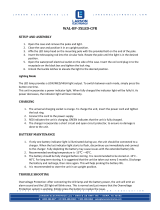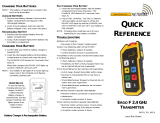
Table of Contents
5100008833IVZ.fm 3
1 Preface ....................................................................................................................................5
2 Introduction ............................................................................................................................6
2.1 Using the manual......................................................................................................................... 6
2.2 Storage location of the manual.................................................................................................... 6
2.3 Accident prevention regulations................................................................................................... 6
2.4 More information.......................................................................................................................... 6
2.5 Target group................................................................................................................................ 6
2.6 Explanation of symbols................................................................................................................ 6
2.7 Wacker Neuson Contact partner ................................................................................................. 7
2.8 Disclaimer.................................................................................................................................... 7
2.9 Product identification of the machine........................................................................................... 7
3 Security ..................................................................................................................................8
3.1 Policy........................................................................................................................................... 8
3.2 Areas of responsibility of the operator......................................................................................... 8
3.3 Operator responsibilities.............................................................................................................. 9
3.4 Personnel qualification................................................................................................................. 9
3.5 General sources of danger.......................................................................................................... 9
3.6 General safety instructions.......................................................................................................... 9
3.7 Specific safety instructions – Vibratory plates ........................................................................... 10
3.8 Specific safety instructions – remote controlled vibratory plates............................................... 10
3.9 General safety instructions - Combustion engines.................................................................... 11
3.10 General safety instructions – fuel, lubricants and coolants........................................................ 11
3.11 General safety instructions – starter batteries........................................................................... 11
3.12 Maintenance.............................................................................................................................. 11
3.13 Personal Protective Equipment ................................................................................................. 12
3.14 Safety devices ........................................................................................................................... 12
3.15 Behavior in dangerous situations............................................................................................... 13
4 Safety and information labels ............................................................................................14
4.1 Safety and information labels on the remote control ................................................................. 15
5 Setup and function ..............................................................................................................16
5.1 Standard package ..................................................................................................................... 16
5.2 Application areas....................................................................................................................... 16
5.3 Short description........................................................................................................................ 16
5.4 Versions..................................................................................................................................... 18
6 Components and operator's controls ................................................................................19
6.1 Components .............................................................................................................................. 19
6.2 Operator's controls .................................................................................................................... 20
6.3 Components and operator’s controls – remote control unit....................................................... 23
7 Transport ..............................................................................................................................25
7.1 Loading and transport................................................................................................................ 25
8 Operation and use ...............................................................................................................27
8.1 Before commissioning ............................................................................................................... 27
8.2 Notes about operation ............................................................................................................... 29
8.3 Commissioning.......................................................................................................................... 30
8.4 Operation................................................................................................................................... 33
8.5 Decommissioning ...................................................................................................................... 36
8.6 Setting the transmission channel (remote control) .................................................................... 41
8.7 Operating the diagnostic menu.................................................................................................. 41
8.8 Operation of the configuration menu ......................................................................................... 42
9 Maintenance .........................................................................................................................43
9.1 Maintenance schedule – One-time maintenance job................................................................. 43
Inhalt






















